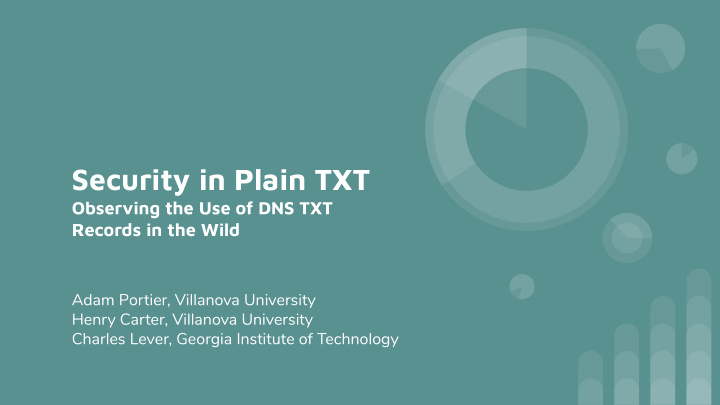



Security in Plain TXT Observing the Use of DNS TXT Records in the Wild Adam Portier, Villanova University Henry Carter, Villanova University Charles Lever, Georgia Institute of Technology
October 2014 DNS Amplification Attack Akamai: Security bulletin: Crafted dns text attack. https://www.akamai.com/us/en/multimedia/documents/state-of-the-internet/dns-txt-amplification-attacks-cybersecurity-threat-a dvisory.pdf (2014)
Why TXT Records? Very little research performed in this area ● Use cases varied and unconstrained ● Expected to find misuse ●
DNS TXT Records
Methodology Collected 1.4 B DNS TXT records collected over a 2 year period ● Developed a taxonomy to describe categories of record uses ● Performed analysis on records ●
ActiveDNS Dataset June 2016 - May 2018
Taxonomy
Protocol Enhancement Records
Protocol Enhancement Takeaways SPF Usage is Increasing ● The majority of domains are using some SaaS for email ● DMARC adoption is slow ● RRSIG coverage was very low (apx 6%) ●
Domain Verification Records
Domain Verification Takeaways Wide variety of SaaS applications requiring verification ● Public documentation poor ● Size and complexity of records vary widely ●
Resource Location Records Found 9,961 records from 4 applications ● Ivanti Landesk ○ Symantec MDM ○ JBoss Fuse ○ Bittorrent ○
Long Tail 8% of the records were initially categorized as “unknown” ● Diminishing returns on patterns ● Wanted to identify if records were structured or random ● Explore if records could be used in amplification attacks ●
Analysis of Long Tail - Entropy
Analysis of Long Tail - Length
Information Leakage
Service Hijacking
Amplification Attacks “What is .tel? The .tel is the only top level domain (TLD) that offers a free and optional hosting service that allows individuals and businesses alike to store and manage all their contact information and media directly in the DNS without the need to build, host or manage a website. A typical top-level domain stores IP addresses in the DNS and returns them when queried. If you do not wish to use the free Telhosting service, that is fine as you can use your .tel for any purpose of your choosing e.g. hosting your own website.”
Summary 52 Distinct Applications ● 3 Categories of Use ● All use cases have potential abuses ● Documentation around when records checked very poor ● Records should be obfuscated ● Unguessable subdomains ○ Remove service specific identifiers ○ Records should be signed with DNSSEC ●
Questions? Adam Portier aporti01@villanova.edu aportier@haverford.edu
Recommend
More recommend